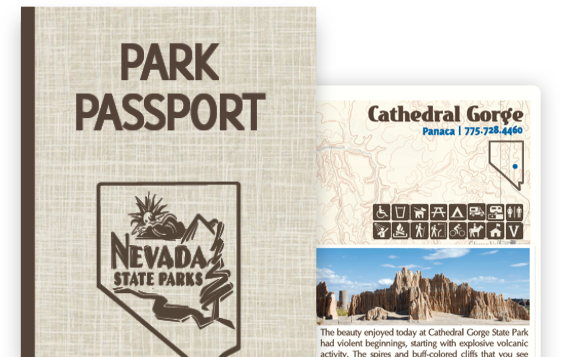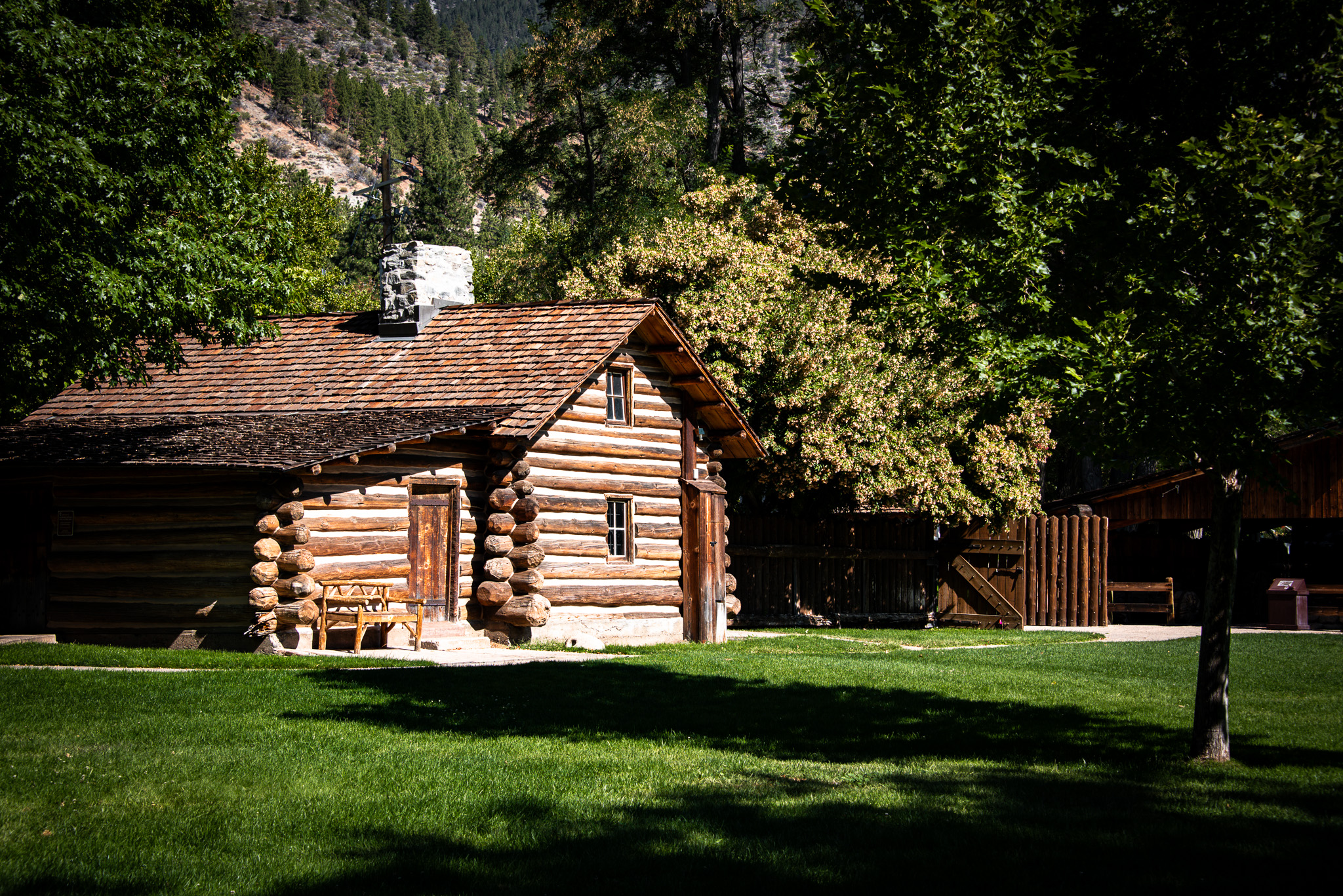-
x
Your Input Needed!
Help shape the future of outdoor recreation by filling out the Statewide Comprehensive Outdoor Recreation Plan survey.
Learn More
Mormon Station
State Historic Park

About Mormon Station
Located in the quaint town of Genoa, Mormon Station’s lush lawns and mature trees make it an idyllic location to gather with friends and family. The site of Nevada’s first permanent, non-native settlement, Mormon Station was built in 1851 as a trading post along the Carson Route of the California Trail, providing much needed supplies to weary travelers crossing the Sierra Nevada Mountains. Today the park is home to a reconstructed version of the original 1851 trading post that burned down in 1910, which operates as a museum with original pioneer artifacts. The park also features the 1856 Kinsey House, one of Nevada’s oldest surviving residences and a prominent example of the financial success of Mormon Station.
FACILITIES & AMENITIES
Group Pavilion: The park's group pavilion accommodates up to 300 people and is available on a reservation-only basis. The site is perfect for weddings, family reunions, barbecues, retirement parties and more. Electricity, a sink, a large counter, barbecue and eight picnic tables are provided.
Museum: The museum is designed to be a replica of the log cabin trading post built by the John Reese Company in 1851. $1 admission fee. Children 12 years and younger are free.
1856 Kinsey House: Located in the east end of the park, the Kinsey House was home to one of the founders of Mormon Station, Stephen Kinsey, who built this home for his new bride Sarah. Park staff are currently working on converting this new part of the property into a walkable part of the park. Check Mormon Station’s news and social media pages for current information on house tours, which we expect to begin in Spring 2026.
Stockade & Wagon Shed: Visit the historic stockade and wagon shed for free.
Self-Guided Interpretive Walking Tour: This 1/2-mile long accessible walking path features several exhibits and interpretive signs that tell the story of 100 years of life in Genoa - from the town's start as a bustling trading settlement in the early 1850s, to its days as a sleepy hamlet in the early 1950s.
The Campbell Homestead: The north end of the park, known today as the "Campbell Homestead," provides a glimpse into life in Genoa in the early and mid-1900s. The property features a historic blacksmith shop, a small apple orchard, an early 1900s chicken house, a demonstration vegetable garden, and the Arribalsaga-Campbell House. Park staff is currently in the process of converting the Arribalsaga-Campbell House (built in 1948) into a Historic House Museum focused on the late 1940s/early 1950s.
1908 Blacksmith Shop: Tour a historic blackmsith shop built in 1908. The shop has been restored to how it would have appeared in the early 1900s,and also features educational exhibits about blacksmithing.
Picnicking/Day Use: The mature trees, large lawns and concrete walkways invite strollers and picnickers. Picnic tables and grills are provided under large shade trees. Restrooms are also available.
Programs: Information about program scheduling may be obtained from either park staff or kiosks. Upon request, special presentations can be arranged for groups.
Hours: The park is always open. Museum hours vary by season:
- May - September: 10 a.m. - 4 p.m., daily
- October - April: 11 a.m. - 3 p.m., closed Tuesdays and Wednesdays
FIELD NOTES
- Pets are welcome (except during special events), but they must be kept on a leash of not more than six feet in length.
- Tree climbing is not allowed.
- Please respect wildlife and keep your distance.
- Removing, disturbing or damaging any historic structure, artifact, rock, plant life, fossil or other feature is prohibited. State and federal laws protect this area and its resources.
- Please use trash, recycling receptacles and dog waste bags.
- The use of drones or any remote controlled aircraft is not allowed. Visit B4UFLY for more info.
- Visitors are responsible for knowing all park rules and regulations in effect. Detailed rules and regulations are posted at the park or may be viewed on the Park Rules page.
- Those with developmental and/or physical limitations are invited to enjoy all of the recreational activities of Nevada State Parks. If you would like to request additional support or accommodations, please call the Nevada State Parks division office. We continually seek ways to provide recreational opportunities for people of all abilities and welcome any suggestions you may have.
- VIew a list of frequently asked questions.
NATURAL RESOURCES/CLIMATE
Genoa is located within the Carson River Basin, at the base of the eastern slope of the Sierra Nevada. This slope constitutes a major watershed area for the ranchers of the Carson Valley. The park is situated within the town limits of Genoa, which has had continuous cultural and agricultural activity for more than a century. Mormon Station exhibits no characteristics of the natural vegetative communities of the region. Many of the existing trees were planted in the 1800s. The surrounding area transitions from the sage brush/ salt brush plant community of the Great Basin Valleys, to the moist, tree covered slops of the Sierra. (READ MORE)
HISTORY OF MORMON STATON STATE HISTORIC PARK – Established in 1957
Mormon Station was built in 1851 as a trading post along the Carson Route of the California Trail. With the discovery of gold in 1848, thousands upon thousands of emigrants starting making their way through present day Nevada along the California Trail. With the last stop for supplies along the California trail being in Salt Lake City, more than 500 miles away, a trading post was desperately needed to supply travelers before they crossed the Sierra Nevada Mountains. A previous “Mormon Station” had been strung together by Abner Blackburn and Hampton Beatie the year before. They constructed, along with five other men, a shelter of just four log walls during the late spring of 1850. This structure did not have a floor or a roof, as it did not rain that summer. During this time, supplies were sold at high prices and Beatie accumulated more than 100 horses from the traveling emigrants. Beatie sold the incomplete trading post and traveled back to Salt Lake City in September of 1850. On the trip back, somewhere on the Humboldt River, Beatie’s party was attacked by Native Americans and all horses and supplies were lost. (READ MORE)
get outdoors
Find a Park Event
push your boundaries
Explore More Nevada State Parks

Dayton
Overflowing with willows, sagebrush and cottonwoods, the park is a picturesque site for camping, picnicking and hiking. Its riches also include the remains of a 1860s silver mill, one of the first to process ore from the Comstock Lode.
- Quick Look
- Full Park Detail

Dayton
Dayton, Nevada- Amenities
- View Description
- Full Park Detail

Sand Harbor
With crystal-clear waters, long sandy beaches, rocky coves, shady forested areas and panoramic lake views, Sand Harbor offers visitors unparalleled opportunities to enjoy and explore Lake Tahoe and also hosts the Lake Tahoe Shakespeare Festival every summer.
- Quick Look
- Full Park Detail

Sand Harbor
Incline Village, Nevada- Amenities
- View Description
- Full Park Detail

Washoe Lake
With breathtaking views of the Sierra Nevada and Virginia mountain ranges, Washoe Lake is a popular area for hiking, camping, water sports, picnicking and equestrian activities. Bird watchers delight in the diversity of migratory birds and waterfowl.
- Quick Look
- Full Park Detail

Washoe Lake
Carson City, Nevada- Amenities
- View Description
- Full Park Detail




